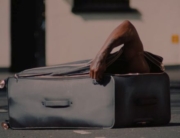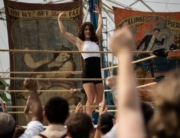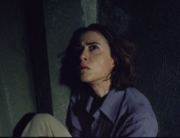Star-turned-cowriter/producer/director Don Cheadle said the goal of his passion project was to bring jazz musician Miles Davis to life on screen for an unconventional biopic and to play the artist himself. He received the family’s approval and even raised some of the completion funds from fans online. At a press conference at last year’s New York Film Festival, he emphasized that he felt that the human side of Davis had been neglected, especially his sense of humor. On those terms, in Miles Ahead, Cheadle has somewhat partially succeeded. But, referencing Davis’s album Sketches of Spain (1960), this comes across mostly as “Comic Sketches of Miles,” with the musical, beating heart of the film coming in the middle upon the late appearance of his muse and a finale concert.
Like many biopics about real and fictional creative geniuses, the film opens at a reclusive period of Davis’s life in the late 1970s, with a reporter trying to obtain a rare interview after Davis has retreated from public view. This was attributed to a variety of physical ailments and addictions, portrayed here as disabling writer’s block. (His brownstone retreat portrayed is full of his actual paintings, and it’s fun to hear Davis complaining about what DJ Phil Schaap was playing on his WKCR jazz program.) The pushy white reporter, Dave Braden (Ewan McGregor), claims to be from Rolling Stone, and is determined to counter reports that Davis is dead. Of course, their clash is immediate, as Davis whispers “Don’t call it jazz! Call it ‘social music.’”
Conventional humor takes over because the reporter isn’t the only one after Davis. Thugs have been sent out from The Suits at The Record Company. Columbia is here represented by a fictional Harper Hamilton (Michael Stuhlbarg, in the type of role that lately has been played by Paul Giamatti). They want his contractually required master tapes for an album for which they already paid an advance. A goon breaks into the house and steals the tapes, so Davis sets off with the reporter to get the masters back. What follows is a New York City road movie (filmed mostly in Cincinnati) and comic capers.
But the chase also sets off flashbacks that are the most effective scenes in the film, when young trumpeter Junior (Keith Stanfield) reminds Davis of his younger self and glimpses of a beautiful young black woman bring to his mind his first wife, the successful ballet and Broadway dancer Frances Taylor (a dazzling Emayatzy Corinealdi). As Davis’s muse, Taylor was on the cover of three of his albums and inspired his interest in flamenco, which led to Sketches of Spain. Cheadle succinctly depicts the trajectory of their 10 years together (1958–1968), from a sexy romance to Davis’s sad change into an increasingly domineering, controlling, and ultimately abusive husband. It is honest and harrowing, making for a jarring contrast with the sitcomy adventures going on in the 1970s-set scenes.
The music finally emerges from the thematic background to the fore in the concluding tribute concert, with Cheadle surrounded by jazz legends, many of whom played with Davis, including Herbie Hancock and Wayne Shorter, to newer performers, Esperanza Spaulding and guitarist supreme Gary Clark Jr. Cheadle said he wanted to make a film that Davis would enjoy appearing in, and the actor certainly seems like a returning ghost in the concert sequence.
Also now available on DVD is a more sustained, frank portrait of a brilliant jazz contemporary of Davis done in by drugs while attempting to sustain relationships and a comeback, Ethan Hawke as trumpeter Chet Baker in Robert Budreau’s Born to be Blue. You can witness the ravages directly in Bruce Weber’s Baker documentary Let’s Get Lost.
















Leave A Comment